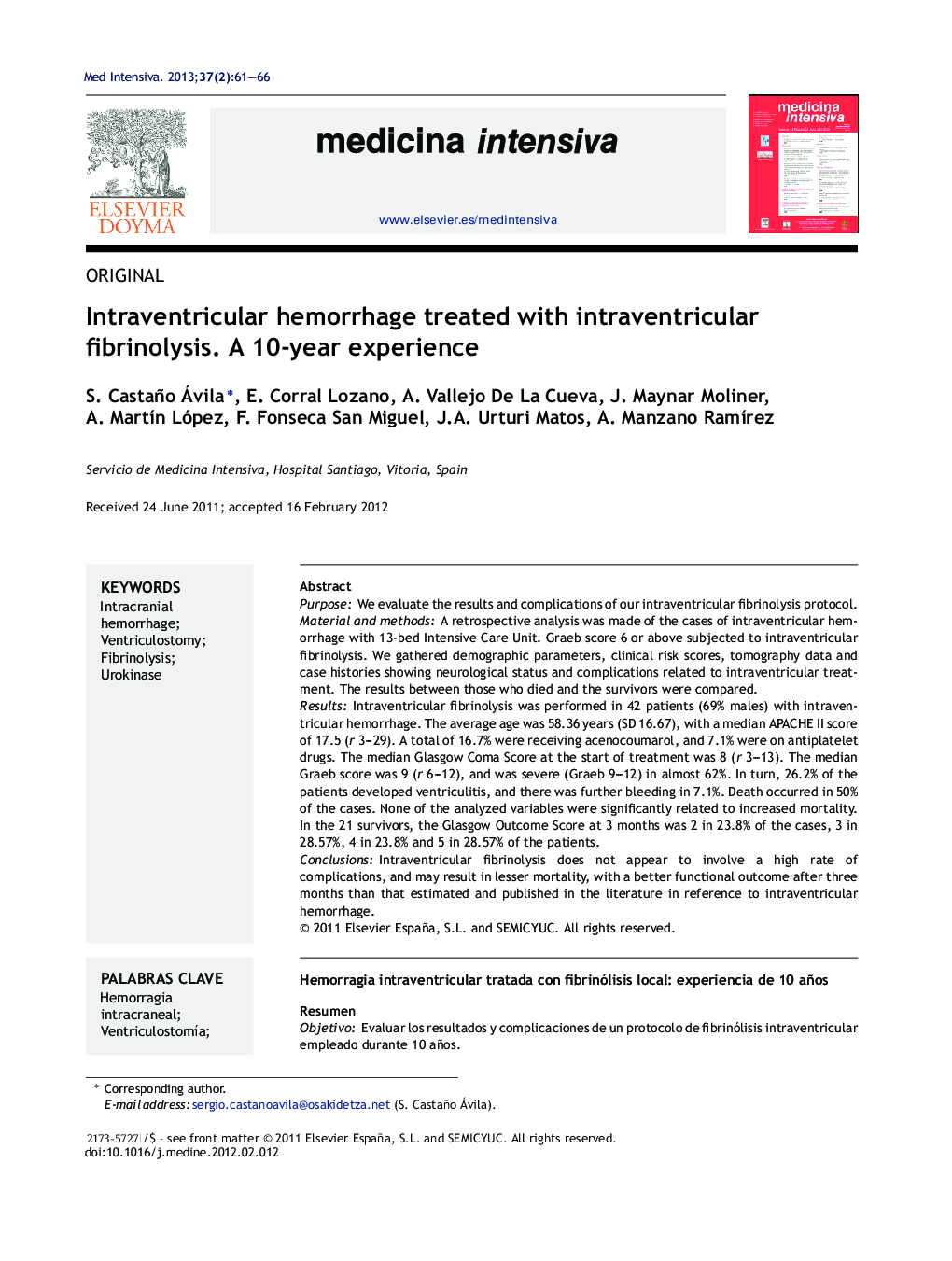| کد مقاله | کد نشریه | سال انتشار | مقاله انگلیسی | نسخه تمام متن |
|---|---|---|---|---|
| 3114245 | 1192505 | 2013 | 6 صفحه PDF | دانلود رایگان |

PurposeWe evaluate the results and complications of our intraventricular fibrinolysis protocol.Material and methodsA retrospective analysis was made of the cases of intraventricular hemorrhage with 13-bed Intensive Care Unit. Graeb score 6 or above subjected to intraventricular fibrinolysis. We gathered demographic parameters, clinical risk scores, tomography data and case histories showing neurological status and complications related to intraventricular treatment. The results between those who died and the survivors were compared.ResultsIntraventricular fibrinolysis was performed in 42 patients (69% males) with intraventricular hemorrhage. The average age was 58.36 years (SD 16.67), with a median APACHE II score of 17.5 (r 3–29). A total of 16.7% were receiving acenocoumarol, and 7.1% were on antiplatelet drugs. The median Glasgow Coma Score at the start of treatment was 8 (r 3–13). The median Graeb score was 9 (r 6–12), and was severe (Graeb 9–12) in almost 62%. In turn, 26.2% of the patients developed ventriculitis, and there was further bleeding in 7.1%. Death occurred in 50% of the cases. None of the analyzed variables were significantly related to increased mortality. In the 21 survivors, the Glasgow Outcome Score at 3 months was 2 in 23.8% of the cases, 3 in 28.57%, 4 in 23.8% and 5 in 28.57% of the patients.ConclusionsIntraventricular fibrinolysis does not appear to involve a high rate of complications, and may result in lesser mortality, with a better functional outcome after three months than that estimated and published in the literature in reference to intraventricular hemorrhage.
ResumenObjetivoEvaluar los resultados y complicaciones de un protocolo de fibrinólisis intraventricular empleado durante 10 años.Ámbito de aplicación y métodosServicio de Medicina Intensiva de 13 camas. Análisis retrospectivo de nuestra base prospectiva de pacientes con hemorragia intraventricular con Graeb mayor de 5 tratados con fibrinólisis intraventricular. Registramos datos demográficos, escalas de gravedad, datos tomográficos y evolutivos neurológicos, y complicaciones relacionadas con la fibrinólisis. Comparamos los resultados entre fallecidos y supervivientes.ResultadosRecibieron fibrinolíticos intraventriculares 42 pacientes (69% varones) con hemorragia intraventricular. La edad media fue 58,36 años (DE 16,67), con una mediana de APACHE II de 17,5 (rango 3-29). El 16,7% tomaban acenocumarol y el 7,1% estaban en tratamiento antiagregante. La mediana del Glasgow Coma Score en el momento de inicio de la fibrinólisis fue de 8 (rango 3-13), y la mediana de Graeb fue 9 (rango 6-12). Más del 62% de las hemorragias fueron clasificadas como graves (Graeb 9-12). Se complicaron con ventriculitis el 26,2% y con sangrado el 7,1%. Falleció el 50% de la serie. Ninguna de las variables analizadas se relacionó de modo significativo con la mortalidad. De los 21 supervivientes, el Glasgow Outcome Score a los 3 meses fue de 2 en el 23,8%, de 3 en el 28,57%, de 4 en el 23,8% y de 5 en el 28,57%.ConclusionesLa fibrinólisis intraventricular no parece asociar una alta tasa de complicaciones, y puede contribuir a una menor mortalidad con mejor resultado funcional a los 3 meses que la estimada y publicada en la hemorragia intraventricular.
Journal: Medicina Intensiva (English Edition) - Volume 37, Issue 2, March 2013, Pages 61–66